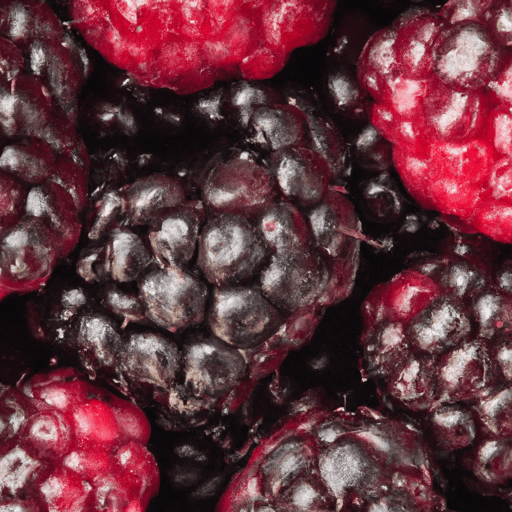Exploring the Delicious World of Boysenberries
When it comes to delightful berries, the boysenberry takes the spotlight with its juicy and tangy-sweet flavor. This delectable fruit, a cross between raspberry, blackberry, and loganberry, captivates the taste buds and opens up a world of culinary possibilities. In this blog post, we will delve into the enticing realm of boysenberries, exploring their taste, common uses in cooking, nutritional value, and uncovering some interesting history and facts along the way.
Taste of Boysenberries: A Perfect Blend
Boysenberries present a unique flavor profile that combines the best attributes of their parent berries. Imagine a burst of sweet-tartness in every bite, with subtle notes of raspberry and blackberry dancing on your tongue. The boysenberry’s natural acidity balances perfectly with its sweetness, making it an incredibly versatile ingredient for both sweet and savory dishes.
Culinary Versatility: From Sweet to Savory
Whether you’re baking a pie, creating a savory sauce, or preparing a refreshing summer beverage, boysenberries can elevate your culinary creations to new heights. Here are some common uses of boysenberries in cooking:
- Baked Goods: Boysenberries lend themselves beautifully to pies, tarts, cobblers, and muffins. Their vibrant color and natural sweetness make them the star of any dessert.
- Sauces and Jams: Boysenberries make deliciously rich and tangy sauces and jams. Whether you’re drizzling them over a scoop of vanilla ice cream or spreading them on toast, the result is pure bliss.
- Smoothies and Beverages: Blend boysenberries into smoothies for a refreshing burst of flavor, or infuse them into beverages like lemonades or mocktails for a delightful twist.
- Savory Dishes: Boysenberries can also be used in savory applications. They can be transformed into a delectable glaze for roasted meats, added to salad dressings for a touch of sweetness, or even incorporated into marinades for a unique and enticing flavor.
Nutritional Value: A Berry Rich in Goodness
Aside from their wonderful taste, boysenberries also offer an array of nutritional benefits. Here’s a glimpse into the goodness that these berries bring to the table:
- Vitamins and Minerals: Boysenberries are packed with vitamins C and K, as well as essential minerals like potassium and manganese. These nutrients contribute to overall health and well-being.
- Antioxidant Powerhouse: Rich in antioxidants, boysenberries help protect against cell damage caused by harmful free radicals in the body. Additionally, their vibrant color indicates a high concentration of beneficial compounds.
- Dietary Fiber: Boysenberries are a great source of dietary fiber, which not only aids in digestion but also helps maintain healthy cholesterol levels and promotes feelings of fullness.
- Hydration: With a water content of over 85%, boysenberries contribute to hydration and help maintain a healthy fluid balance.
A Fascinating Berry: History and Fun Facts
The boysenberry, named after its creator Rudolph Boysen, has an intriguing backstory. Rudolph Boysen, a horticulturist, experimented with crossbreeding various berries in the early 20th century. His efforts resulted in the creation of this remarkable fruit. However, it was Walter Knott, a famous farmer, who popularized the boysenberry by cultivating it commercially and using it to make mouthwatering pies at his Southern California farm.
Here are some additional fun facts about boysenberries:
- Boysenberries are believed to have originated in California.
- They have a relatively short growing season, typically from late spring to early summer.
- Boysenberries are not only tasty but also a visually appealing treat, thanks to their dark purple-red color.
Conclusion
With its unique blend of flavors, versatility, and nutritional value, the boysenberry is a true gem in the realm of berries. From delectable desserts to savory delicacies, this fruit shines in a multitude of culinary creations. So, the next time you come across boysenberries, embrace their irresistible taste and explore the endless possibilities they offer.
Interesting Facts About Boysenberry:
Origin and History: The boysenberry is a hybrid fruit that was developed in the early 20th century by a horticulturist named Rudolph Boysen. It was created by crossing the European raspberry, European blackberry, American dewberry, and loganberry. Boysenberries were first grown on Boysen’s farm in California, and the berry’s popularity grew when farmer Walter Knott began cultivating and selling them in the 1930s.
Appearance and Taste: Boysenberries are large, dark purple berries with a tangy and sweet flavor. They resemble blackberries, but are softer and juicier. The berries are typically harvested when they are fully ripe and have a shiny, deep color.
Common Uses in Cooking: Boysenberries are versatile and can be used in a variety of culinary applications. They are commonly used in pies, jams, jellies, sauces, and syrups. Their vibrant color and distinct flavor make them a popular choice for desserts like cobblers, crumbles, and fruit salads. Boysenberry juice and concentrate are also available and used in beverages.
Nutritional Benefits: Boysenberries are rich in antioxidants, specifically anthocyanins, which give them their deep purple color. Anthocyanins have been associated with various health benefits, including reducing inflammation and promoting heart health. Boysenberries are also a good source of vitamin C, dietary fiber, and contain minerals such as potassium and manganese.
Unique Properties: One unique aspect of boysenberries is their ability to stain. The deep purple juice can leave lasting stains on fabric, countertops, and other surfaces, so caution is advised when handling the fruit or its juice. Additionally, boysenberries have a relatively short shelf life, often lasting only a few days once ripe. They are best enjoyed fresh or preserved shortly after being harvested.
Cultural Significance: Boysenberries hold cultural significance in California, particularly in the Buena Park region where Walter Knott established his berry farm. The success of Knott’s Berry Farm, a popular theme park in California, can be traced back to the cultivation and commercialization of boysenberries by Walter Knott. The theme park was originally a roadside stand that sold boysenberry products, and it has since become a symbol of the boysenberry’s influence on the region’s culture and economy.




Use the share button below if you liked it.
It makes me smile, when I see it.